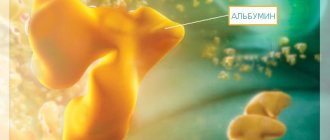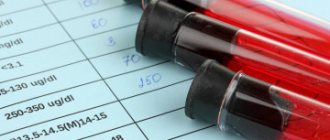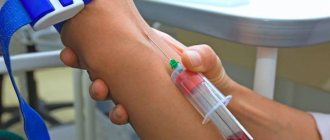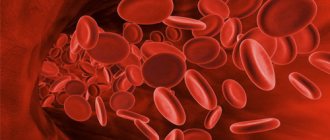What is ESR: methods of determination
ESR is an analysis that determines the rate at which blood is divided into plasma and red blood cells.
The indicator is displayed in millimeters of plasma deposited over red blood cells per hour. The degree of crowding of blood platelets indicates the presence of an inflammatory process. The analysis refers to studies that have little specificity - a low ESR in the blood does not indicate that there is no inflammatory process.
There are a number of methods for determining the indicator, but two of them are used: according to Panchenkov and the capillary photometry method. With the Pachenkov method, uncoagulated blood is placed in a vertically located capillary pipette with a scale of 100 mm, and after an hour the settled red blood cells are counted.
Capillary photometry – analysis using automatic analyzers TEST1. At the beginning of the test, the samples are mixed to disaggregate the red blood cells. The analyzer measures the movement of red blood cell aggregation. The method is similar to the Westergren method, which is considered a model for determining ESR and has the same reference values.
Blood for analysis is taken from a vein by puncture or from the phalanx of a finger. The analysis time for all methods does not exceed one working day.
Why are ESR levels elevated?
Excessively high values of this indicator indicate excess fibrinogen in the blood. This protein is released in large quantities during inflammatory or necrotic processes. Therefore, the more severe the inflammatory or infectious diseases, the higher the erythocyte sedimentation rate.
Autoimmune diseases also affect ESR levels - rheumatoid arthritis, systemic lupus erythematosus or multiple myeloma. An increased rate of red blood cell precipitation in these conditions is observed due to an overactive immune system.
Other reasons causing an increase in ESR levels in the blood:
- Diseases of the excretory system;
- Benign or malignant neoplasms of various etiologies;
- Toxic, viral or idiopathic hepatitis;
- Severe injuries to various parts of the body;
- Diseases of the thyroid gland (thyrotoxicosis);
- Diabetes;
- Infarction of the kidneys, myocardium, lungs;
- Purulent processes;
- Anemia (hemolytic, iron deficiency, idiopathic);
- Hypercholesterolemia;
- Long-term use of oral contraceptives;
- Hydremia (severe blood thinning);
- Chronic heart, liver or kidney failure;
- High blood pH;
- Long-term use of non-steroidal anti-inflammatory drugs (aspirin).
Autoimmune diseases
During pregnancy, ESR levels increase sharply. However, this is considered a variant of the norm and does not pose a danger to either the fetus or the mother.
Causes of elevated ESR
In order to understand how to lower ESR, you first need to find out the possible reasons for the increase in this indicator. ESR may increase due to pathological and physiological factors.
When the erythrocyte sedimentation rate has increased due to reasons other than disease, it may be due to the following factors:
In pregnant women, ESR is almost always elevated, and the indicator returns back to normal only after the birth of the child, somewhere in the second week after birth.
With regular monthly menstruation, elevated levels are not a reason for excessive concern and urgent examination.
If the level of hemoglobin in the blood is low, a change in the shape of red blood cells may be an important factor. Also, with an increase in cholesterol, the composition of the blood plasma can change, which, in turn, leads to accelerated sedimentation of blood cells.
There are other reasons as a result of which the ESR indicator may deviate from the norm:
- increased number of blood cells (polycythemia);
- increased blood acidity;
- taking nonsteroidal analgesics;
- in case of chronic heart failure;
- a modified form of blood red cells, inherited.
To determine the specific cause of changes in ESR, of course, you need to conduct a full medical examination.
The variety of possible causes of an increased erythrocyte sedimentation rate suggests that when the next problem appears, you should definitely entrust the situation to an experienced specialist.
An increased rate of erythrocyte sedimentation in the blood of a child in most cases is caused by inflammatory processes in the body.
In addition, other factors can be identified that lead to an increase in ESR in children:
- impaired metabolism;
- injury received;
- acute poisoning;
- stressful state;
- autoimmune diseases;
- allergic reaction;
- the presence of sluggish infectious diseases or common helminths.
In children, an increased erythrocyte sedimentation rate can occur due to an unbalanced diet, a deficiency of essential vitamins, and also in the case of teething.
If a child complains of general malaise, you should definitely contact a specialist and conduct a comprehensive examination of the body.
After receiving the results, the doctor can identify the main cause of the increased ESR, and after that the necessary treatment will be prescribed.
What are the causes of high ESR?
If the results of a laboratory test reveal a discrepancy with the usual norm, there is no need to be nervous and immediately engage in self-medication, taking it as a way to solve the problem. You need to monitor deviations in the direction of increasing or decreasing ESR in stages. This applies to cases where there are no obvious symptoms of the disease. For example, women may have different ESR levels at different ages. For a girl, the norm is from 3 mm/h, and for a mature and elderly woman – up to 53 mm/h. Therefore, doctors first take into account the patient’s age, and then other factors.
The value of this indicator largely depends on the content of various proteins in the blood plasma.
This means that in any pathological condition that can lead to the rapid formation of these substances in the human body, an increase in ESR occurs. These conditions include:
- inflammation of the respiratory tract, genital organs, kidneys, etc.;
- serious infectious diseases (tuberculosis, syphilis);
- autoimmune diseases;
- myocardial infarction;
- malignant tumors;
- poisoning;
- severe injury to soft tissues and others.
When the cause is oncology, the coefficient will be much higher than normal. Cancerous tumors in the lungs, kidneys, respiratory and other organs can be determined by the dynamics of the coefficient growth to 30-40 units.
In addition, the erythrocyte sedimentation rate can be increased with anemia, excess weight, kidney disease, and the use of medications. In addition, there are physiological reasons for the active growth of ESR. This is the patient’s age, or more precisely, the changes that occur in the body due to age. In women, the indicator may be higher than normal on menstrual days, during pregnancy. As for pregnant women, this figure is doubled, as the blood is diluted and its protein composition is disrupted. After the birth of a child, an elevated ESR remains for some time.
How to lower or reduce ESR in the blood in women and men
Content
Many people wonder how to lower ESR in the blood of women. To answer correctly, you need to understand the meaning of ESR in the body. Further it will become clear that there is no specific way to reduce its level, but the cause can be dealt with. The main thing is to understand the reason that caused this condition.
In order to notice pathology in time, you need to attend scheduled examinations and donate blood for analysis. It is worth going to the doctor not only in case of serious reasons. It is recommended to donate blood at least once a year. In case of deviations, the doctor will select conservative treatment.
Concept of erythrocyte sedimentation rate
An erythrocyte is one of the many elements of blood. The erroneous opinion of many is that the main value in analyzes is the concentration of red blood cells. Pay attention to the rate of their settling. A normal ESR in a general analysis indicates the patient’s health. When the level of ESR in the blood is too high, one can judge the presence of some pathology.
The patient's blood is drawn early in the morning on an empty stomach. It is left in the test tube for an hour. To prevent clotting, a special serum is added. After which you can see a clear line. From this moment this indicator is determined. A decrease or increase indicates the presence of a particular disease.
Throughout life, various changes occur in the body. When viruses or infections occur, the number of different blood cells changes. Research can reveal even this. For the female body, the norm for ESR is considered to be from 3 to 15 mm/h.
For comparison, you can present other figures:
- For men, the norm is considered to be from 1 to 10 units.
- For children, the norm is considered to be from 0 to 2 units.
- For infants, the norm is considered to be from 12 to 17 units.
Absolutely any violations committed during blood sampling can affect further results. These include errors in the research technique or lack of proper experience of the laboratory assistant.
Causes of high ESR levels in the blood of women
A decrease or increase in ESR levels should be treated in several stages. Often there are no symptoms. If you take different ages of women, then the indicators will be different. For younger people, the typical indicator is 3 units, and for older people it can increase to 53 units. And that's okay. Proteins contained in blood plasma also affect ESR.
The following diseases lead to an increase in ESR:
- inflammation of various organs;
- infectious diseases;
- autoimmune disorders;
- heart diseases;
- cancer;
- intoxication of the body;
- severe injuries.
In the presence of cancerous tumors, the ESR level reaches significant levels, in some cases very high values were recorded.
The ESR indicator in the general analysis may be increased due to anemia, obesity, renal failure, or when taking certain medications.
This coefficient is also influenced by other reasons, which include:
- age-related changes;
- menstruation;
- pregnancy.
In pregnant women, the erythrocyte sedimentation rate is almost twice as high, because during this period there is a change in the protein composition of the plasma. When the baby is born, the mother’s ESR level remains at a high level for a short period of time, but then returns to its original normal.
It is important to remember to remain calm with any results you receive. Many people immediately begin searching for self-medication. This is the wrong decision. Only a doctor can identify the disease and begin appropriate treatment.
How to reduce ESR in the blood or how to reduce ESR? These are the most common questions asked in search engines. If everyone knew that only a doctor can give the correct answer, because no one can determine the cause of such a condition themselves. As soon as it is eliminated and eliminated, the ESR level will decrease on its own.
To eliminate the cause, a comprehensive examination of the patient is performed. After which a certain course of treatment is prescribed. Don't expect quick results - everything will come with time. The main thing is to follow the recommendations. A rapid jump from a higher to a lower reading can affect the functioning of the cardiovascular system.
Some experts recommend that during direct treatment, take additional remedies that you can prepare yourself.
The most effective are considered:
- herbal decoctions;
- honey and honeycombs;
- beet broth;
- lemon mixed with crushed garlic.
The consequences of self-medication can be very unpleasant. Many people start taking antibiotics or other anti-inflammatory drugs.
This method will not cure the underlying problem; it will most likely cause irreparable harm to the body, which can later develop into a chronic disease.
Methods for reducing ESR in the blood of women
If ESR is elevated, you can use herbal decoctions, for example:
- chamomile;
- coltsfoot;
- Linden;
- horsetail;
- other anti-inflammatory herbs.
When the patient does not have an allergic reaction to honey, then it can be consumed in small doses daily.
Beetroot broth will help cleanse the blood. A well-washed root vegetable is boiled in its skin for about three hours. The resulting broth must be filtered and cooled. Drink 50 grams before breakfast for about seven days.
Garlic with lemon juice has the same effect on the blood as beets. To prepare this healing mixture, you need 0.5 kg of chopped garlic and the juice of 30 lemons. You can reduce the proportions, but this amount is necessary for one course. It should be stored in a cool, dark place. Before use, dilute 1 teaspoon in 200 ml of boiled water. Drink before bed.
Reducing red blood cells using folk remedies alone is useless; the effect will be, but temporary. But such methods can be an excellent addition to a doctor's prescription.
Rate this article:
We recommend reading:
boleznikrovi.com
Is it necessary to reduce ESR?
You cannot diagnose yourself based solely on ESR readings in tests, whether a patient’s ESR is increased or decreased
It is important to approach this comprehensively, to analyze the condition of the whole organism as a whole, the presence of chronic diseases, past illnesses... The doctor may prescribe a general diagnosis of the whole organism:
- Referral for biochemical blood test
- Check with a cardiologist, ESR deviates from the norm if myocardial infarction is suspected
- Checking for infections and inflammations in the body
- ESR in oncology
When the cause of an increased or decreased ESR is identified, the stage of the disease is determined, only then treatment is prescribed and the result of therapy is observed.
In addition, your diet should be rich in fiber and protein foods of natural origin.
Avoid processed foods and foods containing carcinogens.
The following products that effectively reduce ESR in the blood will be useful:
- black chocolate,
- citrus,
- fresh vegetables,
- especially red beets.
It is with their help that you can quickly and without harm normalize the erythrocyte sedimentation rate in the blood and at the same time cleanse the blood.
Taking certain medications can lower the ESR level for a while:
- calcium chloride,
- medicines that contain mercury,
- salicylates (salicylic acid, aspirin).
- Side effects of morphine, dextran, methyldorf, B vitamins).
In anemia, the erythrocyte sedimentation rate will decrease if hemoglobin is increased.
In case of significant deviations from the norm of hemoglobin (iron-containing protein), the following is prescribed:
- folic acid,
- "Hemodin"
- "Totem"
- "Irovit"
- "Maltofer."
In folk medicine, it is possible to reduce the erythrocyte sedimentation rate if this is not associated with the acute phases of diseases where the patient’s life is threatened. In case of emergency, you should immediately consult a doctor. Beetroot broth helps a lot.
Several dozen diseases can be hidden behind an ESR value raised above normal. The result of the analysis serves as an impetus for additional and deeper diagnostic procedures to find the cause of increased values above normal. The provoking factors are almost the same for representatives of different sexes, for adults and children.
Increase in men
In both men and women, ESR is higher than normal when:
- diseases of the urinary system;
- various anemias;
- disorders of fat metabolism;
- connective tissue diseases;
- autoimmune and tumor pathologies;
- long-term use of certain medications.
Among women
To the reasons listed above for an increase in ESR, several specific factors unique to women can be added. Their erythrocyte sedimentation rate increases when:
- pregnancy;
- in the first months after childbirth;
- during menstruation.
The reason for the acceleration of ESR above normal is often medications taken by a woman for a long time - hypocholesterol, antihypertensive drugs or contraceptives.
During pregnancy
Pregnancy is considered a physiological cause of ESR deviation above normal. The value of the indicator can increase to 25 mm/h in the second trimester and up to 35 mm/h in the third. Gynecologists look quite calmly even at indicators of 45 mm/h.
If the doctor has the slightest suspicion of the pathological nature of the increased ESR, the woman will be asked to retake tests or undergo additional tests. But most often this is not required, since elevated values during pregnancy are usually associated with iron deficiency anemia, and this condition can also be detected with a general blood test.
As follows from what was written above, ESR above normal is not an independent disease, but only an indirect sign indicating the likelihood of an inflammatory process or infection. Therefore, the only way to lower high values is by curing the underlying disease. Depending on the etiology, this may require drug therapy with antibiotics, antivirals, or anti-inflammatory drugs.
You can help the body cope with the disease faster with the help of immunostimulating agents, if approved by the attending physician. Healthy habits, proper nutrition, and sufficient physical activity will help strengthen your immune system.
Folk remedies that tell you how to reduce ESR should not be taken seriously. But you can heed the advice to drink fruit and vegetable juices, herbal teas and fortified decoctions, as these actions will help get rid of anemia, a common cause of increased ESR.
Reducing ESR using folk remedies
The use of alternative methods is permissible only after consulting a doctor. You can lower ESR in the blood at home with the help of herbs, vegetables, and fruits that help cleanse the blood:
- Herbs. An increased indicator in the analysis indicates an inflammatory process in the body. Its occurrence is influenced by pathogens of the disease. The most common pathogenic microorganisms are staphylococcus, streptococcus, and candida. Tea and infusions of chamomile, calendula, and nettle help effectively. In addition, these plants rarely cause an allergic reaction, so you can brew them and drink them as a preventive measure.
- Garlic with lemon juice is also an effective remedy against pathogenic bacteria. Recipe: Peel 2 heads of garlic and pass through a meat grinder. Pour the resulting slurry completely with freshly squeezed lemon juice. Mix everything well and put it in the refrigerator, take a teaspoon 2 times a day (preferably morning and evening), after meals. This recipe is not recommended for people suffering from hepatitis and gastric ulcers. This is due to the organic sulfides contained in garlic.
- Boiled beets. The root vegetable contains a large number of useful nutrients: B vitamins, retinol, ascorbic acid, iron and others. But potassium is of particular value. This substance plays a huge role in the water-salt balance of the body. Beets can be boiled and eaten as an independent dish, or you can prepare salads in which it will be an ingredient.
In women, a low ESR in the blood may be a sign of a natural physiological process, so you should not get carried away with traditional medicine.
Erythrocyte sedimentation rate is one of the indicators in a general blood test. The presence or absence of an inflammatory process is determined by analyzing all values. ESR increases due to the occurrence of a pathological condition, therefore, if the disease is eliminated, the indicator will be normal.
Research methods
The blood to be tested is placed in a glass capillary marked with a special scale and left in a vertical position. After a while, red blood cells settle in the lower layer, while plasma remains in the upper layer. The adhesion and sedimentation of red blood cells occurs due to the adhesion of proteins related to the human immune system to them.
When any infection enters the human body, the immune system recognizes it and releases several dozen types of protein into the blood to isolate this infection and fight it. The more extensive the damage to the body, the higher the protein concentration in the blood, the higher the erythrocyte sedimentation reaction in the blood test. Thus, by the reaction of blood cells one can judge the existence of an infectious-inflammatory process in the body.
Method for determining ESR
Unfortunately, ESR is a nonspecific blood test and it is impossible to determine the location of the infection using it. But in the future, by comparing test results, you can track the effectiveness of treatment.
Norms depending on gender and age
The gender and age of the subjects influence the ESR values taken as the norm.
- In healthy newborns – 1-2 mm/hour. The reasons for deviations from standard indicators are acidosis, hypercholesterolemia, high hematocrit;
- in children 1-6 months – 12-17 mm/hour;
- in preschool children – 1-8 mm/hour (equal to the ESR of adult men);
- For men – no more than 1-10 mm/hour;
- In women - 2-15 mm/hour, these values vary depending on the level of androgen; from the 4th month of pregnancy, ESR increases, reaching 55 mm/hour by childbirth, after childbirth it returns to normal within 3 weeks. The reason for the increase in ESR is the increased level of plasma volume in pregnant women, cholesterol levels, and globulins.
An increase in indicators does not always indicate pathology; the reason for this may be:
- Use of contraceptives, high molecular weight dextrans;
- Fasting, dieting, lack of fluid, leading to the breakdown of tissue proteins. A recent meal has a similar effect, so blood is taken to determine ESR on an empty stomach.
- Increased metabolism caused by physical activity.
| Age | ESR rate (mm/hour) |
| Newborn babies | 0-2 |
| Infants up to 6 months | 12-17 |
| Children and teenagers | 2-8 |
| Women under 60 years old | 2-12 |
| Women in the 2nd half of pregnancy | 40-50 |
| Women over 60 years old | Up to 20 |
| Men under 60 years old | 1-8 |
| Men over 60 years old | Up to 15 |
Acceleration of ESR occurs due to an increase in the level of globulins and fibrinogen. Such a shift in protein content indicates necrosis, malignant transformation of tissue, inflammation and destruction of connective tissue, and immunity disorders. A prolonged increase in ESR above 40 mm/hour requires other hematological studies to determine the cause of the pathology.
| Age | Norm (mm/hour) |
| Girls under 13 years old | 7-10 |
| Girls - teenagers | 15-18 |
| Women of reproductive age | 2-15 |
| Women over 50 years old | 15-20 |
The normal values for a woman fluctuate depending on changes in her body.
Indications for a blood test for ESR in women:
- Anemia,
- Lack of appetite,
- Pain in the neck, shoulders, headache,
- Pain in the pelvic organs,
- Joint pain,
- Unreasonable weight loss.
| Body type | Norm ESR (mm/hour) in the 1st half of pregnancy | Norm ESR (mm/hour) in the 2nd half of pregnancy |
| Fat women | 18-48 | 30-70 |
| Skinny women | 21-62 | 40-65 |
ESR in pregnant women depends directly on the level of hemoglobin.
| Age | ESR rate (mm/hour) |
| At birth | 1-2 |
| Day 8 | 4 |
| Day 14 | 17 |
| Over 2 weeks | About 20 |
| In preschool children | 1-8 mm/hour |
To have an idea of the normal ranges of the indicator, consider the ESR norms for different groups of subjects. The standards for women, men and children have certain differences.
For representatives of the female population, a wider range of values has been established since youth than for persons of the opposite sex. In girls under 15 years of age, the ESR rate ranges from 2 to 15 mm/h; from 15 to 50 years of age, it is allowed to increase to 20 mm/h, and after 50 – up to 30 mm/h. The erythrocyte sedimentation rate can increase to 45 mm in women expecting a child.
For the strong half of humanity, the following ESR boundaries have been established:
- up to 20 years – 1-10;
- up to 60 years old - 2-15;
- over 60 – up to 20 mm.
The erythrocyte sedimentation rate in children should not exceed 10 mm for boys and 15 mm for girls 10-15 years old. Deviations are considered not only values above normal, but also values of ESR that are too low (less than 1 mm), so pediatricians are looking for reasons why the value increases and why the value decreases.
How to reduce ESR in the blood using folk remedies
Now about how to lower ESR in the blood using folk remedies. In folk medicine, as in traditional medicine, a decrease in blood cell sedimentation rates depends on the treatment of the inflammatory process.
Traditionally, onions and garlic are the most popular in the fight against infections. They have antiviral and bactericidal effects and accelerate blood circulation in humans.
Beekeeping products are no less in demand, especially propolis, bee bread, and bee bread.
Also, folk remedies for lowering ESR in the blood can be herbal decoctions and infusions:
- chamomile and calendula – for inflammatory diseases of the nasopharynx.
- licorice and coltsfoot - for tracheitis and bronchitis.
- milk thistle – for liver pathologies
- herbal infusions – for urinary tract problems.
It should be noted that lowering ESR using exclusively folk remedies is ineffective. Although such methods can provide considerable assistance to drug treatment recommended by a doctor.
The most effective traditional medicines include:
- herbal infusions;
- honey and other bee products;
- beet broth;
- a mixture of lemon juice and garlic.
With an increased rate of red cell sedimentation, a variety of herbal infusions that relieve inflammation are excellent. These include: chamomile flowers, linden and coltsfoot leaves. Medicinal herbs or their mixtures are usually brewed with boiling water and then consumed. Among other effective means that reduce ESR, preference should be given to honey, as well as other beekeeping products. They can only be consumed by people who do not have an allergic reaction to this product.
A remarkable effect can be achieved using a product made from garlic and lemon juice. To do this, the garlic is peeled and crushed, then mixed with squeezed lemon juice.
Children may also experience an increase in this indicator, so parents do not need to panic in vain. This occurs when teething, poor nutrition, or lack of vitamins needed by the body. When a child complains of not feeling well, parents should take him to see a doctor and have him undergo a medical examination.
For infectious or inflammatory diseases, it is recommended to take products based on onions, garlic, lemon, oranges, beets or honey. It is advisable to use infusions and teas based on chamomile, raspberry or coltsfoot.
For allergic diseases, traditional folk methods of treatment are also used. Juice from oranges, grapefruits and lemons helps reduce allergies due to the vitamin C they contain. The use of mint and St. John's wort infusions is effective. Before using the last plant, be sure to consult your doctor.
The most effective means that lower ESR in the blood:
- Garlic juice;
- Raw onion;
- Beet based recipes;
- Melissa.
To improve rheological properties, you need not only to eat right and take infusions, but also to perform physical activity. 1 hour of daily walking at a speed of 8 km/h and breathing exercises are enough to improve ESR parameters.
ESR in blood test
Red blood cells have a peculiarity - under certain conditions they “stick” together, forming cell complexes. Since their mass is much greater than the mass of individual red blood cells, they settle to the bottom of the test tube faster. During the inflammatory process occurring in the body, the rate of red blood cell union increases or, conversely, decreases. Accordingly, the ESR increases or decreases.
The accuracy of blood testing depends on the following factors:
- Proper preparation for analysis;
- Qualifications of the laboratory assistant conducting the research;
- Quality of the reagents used.
If all requirements are met, you can be confident in the objectivity of the research result.
There are two methods for laboratory testing of blood for ESR. They have a common feature - before the study, the blood is mixed with an anticoagulant so that the blood does not clot. The methods differ in the type of biomaterial being studied and in the accuracy of the results obtained.
Panchenkov method
Blood is mixed with an anticoagulant on a special glass in a ratio of 1:4. After this, the biomaterial will no longer coagulate; it is placed in a capillary. After an hour, the height of the blood plasma column separated from the red blood cells is measured. The unit of measurement is millimeter per hour (mm/hour).
Westergren method
A study using this method is the international standard for measuring ESR. To carry it out, a more accurate scale of 200 divisions, graduated in millimeters, is used.
Venous blood is mixed in a test tube with an anticoagulant, and ESR is measured an hour later. The units of measurement are the same – mm/hour.
The erythrocyte sedimentation reaction is measured in a general analysis. For ESR, a blood test is taken on an empty stomach in the morning; before the test you are allowed to drink slightly sweet tea, but a large fatty meal and alcohol the day before significantly affect the test result.
If a person has an increased reaction of red blood cells, but no other symptoms of the disease are detected, the doctor may order a repeat test for erythrocyte sedimentation rate after 6-7 days. We hope we helped you and you now know how to lower the ESR in the blood of an adult and a child.
Let's sum it up
ROE deceleration is a less common phenomenon than acceleration. And in most cases it does not lead to serious complications. But this does not mean that the ROE indicator below the norm does not require correction. Any deviations in the body signal the formation of pathological processes. Therefore, it is advisable to promptly identify and eliminate the cause affecting the erythrocyte sedimentation rate. Be healthy, take care of yourself and your loved ones.
A blood test can tell us many things about the state of our body. Increased sugar, uric acid in the blood - these diseases are on everyone’s lips. But what is ESR and how can its increase affect human health? How to reduce ESR?
How to check ESR?
If a blood test is placed in a glass tube, then under the influence of gravity the red blood cells will settle to the bottom of the tube, thus the blood will be divided into two layers, the upper layer will consist of transparent plasma, and the lower layer will consist of settled red blood cells. It is the erythrocyte sedimentation rate (millimeters/hour) that is the indicator measured to analyze the condition of a person’s blood.
Factors that may affect COE readings
The SOE value can vary depending on many pathological and physiological factors. In women, this figure is slightly higher than in men: 2-15 mm/h and 1-10 mm/h, respectively. In a pregnant woman, the SOE level can rise to 45 mm/h and this will remain the norm, which does not need to be reduced. The rate also increases during menstruation. In such cases, there is no need to reduce the ESR; it is enough to undergo a repeat analysis.
It is better to take a blood test in the morning, because... During the day, the ESR fluctuates; the maximum level is possible when donating blood during the day. In acute and inflammatory processes, the erythrocyte sedimentation rate may change 24 hours after the onset of the disease due to an increase in the number of leukocytes.
Reasons for increasing ESR
An increase in erythrocyte sedimentation rate can signal the onset and development of inflammatory processes in the body. Tissue necrosis in diseases such as tuberculosis or heart attack can also be detected by this analysis. The reason for the increase in ESR also depends on the value of its indicator. When the indicator increases by 40 mm/h and above, the doctor can judge the occurrence of diseases such as: severe pneumonia, purulent inflammation of bone tissue, autoimmune diseases, metabolic diseases of the joints, hematological diseases or even oncological problems. With this indicator, ESR remains elevated for a long time without treatment and is easy to detect. Only a doctor will help you choose treatment and answer your question of how to reduce ESR.
With a slight shift in the indicator to approximately 30 mm/h, we can assume mild, non-purulent inflammatory processes that can occur with: sinusitis, pyelonephritis, prostatitis, inflammatory diseases of the uterine appendages, uncomplicated pneumonia, synthitis, and chronic infectious diseases. By taking additional tests and being examined by a doctor, you can reduce the ESR along with treatment of the identified disease.
An increased ESR may sometimes indicate causes uncharacteristic for its change, such as: diseases of the endocrine system, anemia, trauma, bone fractures, poisoning with pesticides, intoxication, old age, postoperative conditions.
How to reduce ESR?
It is important to remember that an elevated ESR in itself is not a disease or the cause of a disease. Rather, the erythrocyte sedimentation rate is a symptom of the diseases that have already been mentioned above
Thus, it is not the indicator that needs to be treated, but the cause of the indicator. The general practitioner, after analyzing the blood condition, prescribes treatment to reduce ESR or refers you to a specialized specialist.
To reduce EOS, anti-inflammatory infusions of medicinal herbs based on traditional medicine can be taken as an additional treatment. Helps reduce ESR and raw radish, as well as a decoction of beetroot
It is important to remember that traditional medicine can be taken as a parallel treatment, but it should not replace a trip to the doctor. A timely decrease in ESR will help avoid the development of inflammatory processes in the body and prevent the occurrence of serious diseases
Analysis of the ESR indicator is part of a general clinical blood test aimed at identifying pathological conditions of various organ systems. The erythrocyte sedimentation rate may increase due to inflammatory, infectious or idiopathic diseases.
Red blood cells and their sedimentation rate
Normal and pathological ESR values
Patients over 40 years of age should keep in mind that a rise in ESR to 45-50 mm/h can be caused by hidden pathologies:
- deep fractures;
- diseases of the thyroid gland (more than half of older women suffer from them);
- allergic reactions;
- kidney diseases;
- chronic forms of infections;
- growth of tumor formations.
But the acceleration of ROE is not necessarily due to pathological reasons. Some physiological factors can cause an accelerated blood separation reaction:
- use of oral contraceptives;
- gestational and postpartum periods;
- monthly regulations;
- menopause in women.
Menopause is usually accompanied by high levels. An ESR of 40-50 mm/h is considered normal if other blood parameters are within the range of reference values.
ESR during pregnancy
Pregnant women undergo ESR testing 4 times:
- up to 12 weeks of gestation, normal options for this period are 13-45 mm/h;
- at 20-21 weeks, ESR values of 30 mm/h and below are considered normal;
- at 28-30 weeks, ESR increases again, reaching 30-45 mm/h;
- shortly before birth, at which time the ESR is still elevated.
High ESR values (40 mm/h and below) remain in a woman even after the birth of a child, which means that the hormonal levels in the body have not yet been restored. Only after 2-3 months does the condition finally stabilize, and the ESR drops to 0-15 mm/h.
A woman checks her ROE 4 times during pregnancy











